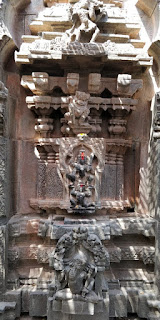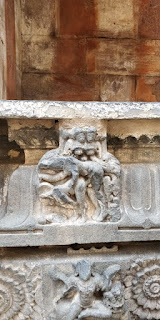This is a temple which generally doesn't fall in a lot of travelers radar. So you can consider it an offbeat location, if you are visiting this temple for its architecture and not for some spiritual reasons. I first read about this temple in Jeyamohan's book. I visited this temple on a sunny summer day with clear blue sky and the the ferocious sun. The area around the temple had lot of big trees which offered some shadow for my car to be parked.
The temple is located in the banks of river Penna and the river was in a sad state with not even a single drop of water flowing in it. The river had some small pits in it where dhobies were washing their clothes and drying it up in the hot sun. The water in the pits didn’t look so fresh as it was stagnant. I again wanted to visit this place when the river is flowing with water. This is not the first time I have crossed Penna, I have been to Gandikota earlier and have crossed Penna enroute to Hyderabad and the way back from Vishakapatnam near Nellore.
The temple is located in the banks of river Penna and the river was in a sad state with not even a single drop of water flowing in it. The river had some small pits in it where dhobies were washing their clothes and drying it up in the hot sun. The water in the pits didn’t look so fresh as it was stagnant. I again wanted to visit this place when the river is flowing with water. This is not the first time I have crossed Penna, I have been to Gandikota earlier and have crossed Penna enroute to Hyderabad and the way back from Vishakapatnam near Nellore.
The temple’s legend and history is well documented in Tadipatri Kaifiyat. As every temple in India this Shiva temple has its own legend. And it’s up to the observer to take in the part of the story he wants and spit out the parts which his brains can’t imagine and believe it to be true.
According to Tadipatri Kaifiyat, Ramalinganayudu, a chieftain of the Vijayanagara empire tasked with the administration of Gandikota seema built this temple. When Ramalinga’s cows were taken to the fields to graze, one particular animal used to empty its milk on an ant-hill. The cowherd had hurled an axe at the ant-hill. The night Ramalinga has a dream in which the Lord told him the cowherd had harmed him. Ramalinga was asked to build a temple at the spot. And now you have this beautiful temple.
By the looks of us, people there understood the purpose of our visit and one local guy came forward to show us the temple. Since I was not able to speak his local language, it was difficult to converse with him. But nonetheless, he was helpful.
The temple adheres to dravidian architecture of temples. It has three gopuras with a compound wall and the inner sanctum sanctorum. The sanctum sanctorum is plain and since we had reached there in the afternoon we were not able to witness the deity. The gopuras had a lot of beautiful statues and was dark black in color. This might be due to the dark black stone available in the region.
I am not even going to try to explain how beautiful the temple was. My mere words will not do justice to the beauty of the temple. Go visit the temple to dive and enjoy its beauty.
And the best part is you can cover this on a weekend road trip from Bangalore. We had started early morning from Bengaluru to Belum caves. We tried to reach Belum caves by the time they open the counter as it gets hot so soon. And then we visited Tadipatri en route to Gandikota. We camped in Gandikota for the night and started back to Bangalore on Sunday morning and checked out Lepakshi on the way back.
















